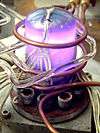Stirling radioisotope generator
The Stirling radioisotope generator (SRG) is a generator based on a Stirling engine powered by a large radioisotope heater unit. The hot end of the Stirling converter reaches high temperature and heated helium drives the piston, heat being rejected at the cold end of the engine. A generator or alternator converts the motion into electricity. Given the very constrained supply of plutonium, the Stirling converter is notable for producing about four times as much electric power from the plutonium fuel as compared to a radioisotope thermoelectric generator (RTG). The Stirling generators were extensively tested on Earth by NASA, but their development was cancelled in 2013 before they could be deployed on actual spacecraft missions. A similar NASA project still under development as of 23 June 2020, called Kilopower, also utilizes Stirling engines, but uses a small uranium fission reactor as the heat source.

SRG
Stirling engine development began at NASA Glenn Research Center (then NASA Lewis) in the early 1970s. The Space Demonstrator Engine (SPDE) was the earliest 12.5 kWe per cylinder engine that was designed, built and tested. A later engine of this size, the Component Test Power Converter (CTPC), used a "Starfish" heat-pipe heater head, instead of the pumped-loop used by the SPDE. In the 1992-93 time period, this work was stopped due to the termination of the related SP-100 nuclear power system work and NASA's new emphasis on "better, faster, cheaper" systems and missions.
ASRG
In the early 21st century, a major project using this concept was undertaken: the Advanced Stirling Radioisotope Generator (ASRG), a power source based on a 55-watt electric converter.[1] [2] The thermal power source for this system was the General Purpose Heat Source (GPHS). Each GPHS contained four iridium-clad Pu-238 fuel pellets, stood 5 cm tall and 10 cm square, and weighed 1.44 kg. The hot end of the Stirling converter reached 650 °C and heated helium drove a free piston reciprocating in a linear alternator, heat being rejected at the cold end of the engine. The alternating current (AC) generated by the alternator was then converted to 55 watts direct current (DC). Each ASRG unit would use two Stirling converter units with about 500 watts of thermal power supplied by two GPHS units and would deliver 100-120 watts of electric power. The ASRG underwent qualification testing at NASA Glenn as a power supply for a future NASA mission. The ASRG was designed into many mission proposals in this era,[3] but was cancelled in 2013.[4]
References
- ASRG data sheet(NASA Glenn) Archived September 29, 2012, at the Wayback Machine and DOE info Archived 2011-09-27 at the Wayback Machine.
- NASA Technical Memorandum TM-2007-214806 Archived 2009-06-05 at the Wayback Machine (2007), (accessed May 3, 2011)
- B. Berger - Discovery Mission Finalists Could Be Given Second Shot (2014)
- The ASRG Cancellation in Context Future Planetary Exploration
External links
- NASA Stirling Engine Based Nuclear Power Plant For Lunar Use on YouTube
- Radio Isotope Power Systems for the New Frontier
- Stirling Converter Technologies at NASA Glenn Research Center
- Why Develop a Stirling Radioisotope Generator?
- Wolverton, Mark (March 2008). "Stirling in Deep Space". Scientific American.
See also
- Advanced Stirling Radioisotope Generator
- Radioisotope thermoelectric generator
- Radioisotope heater unit